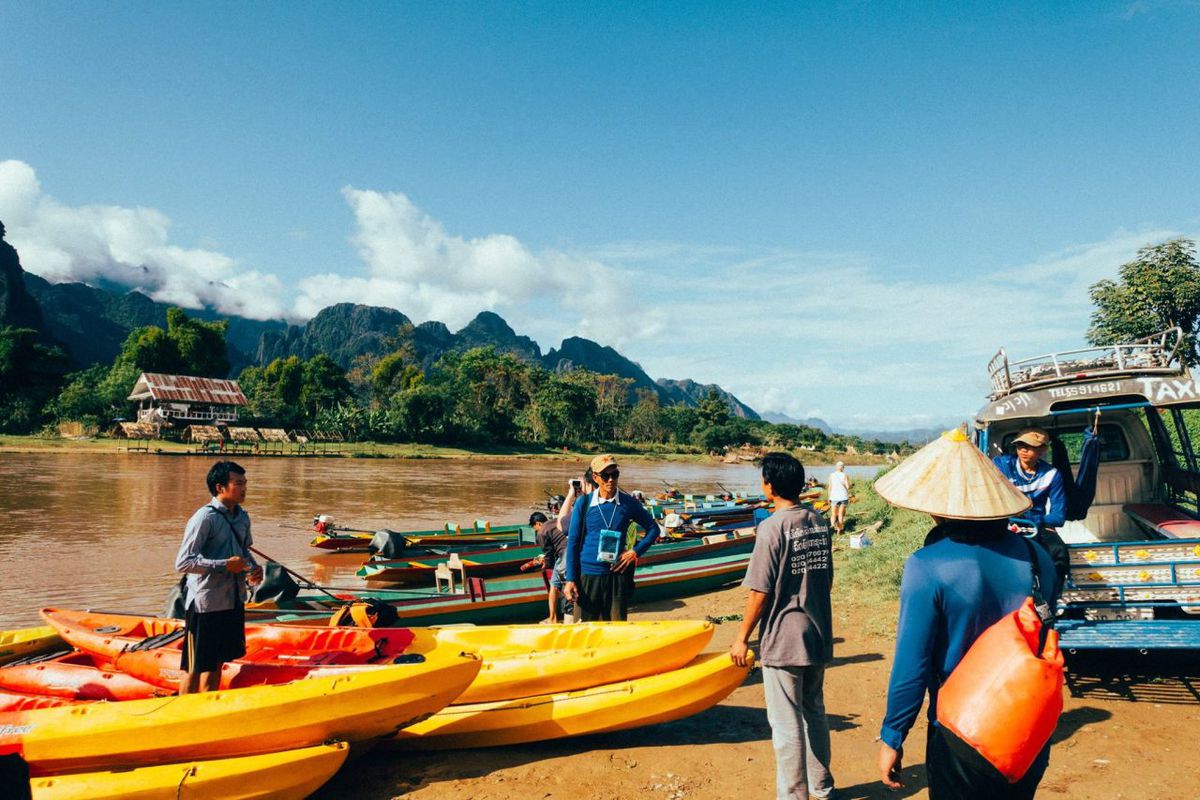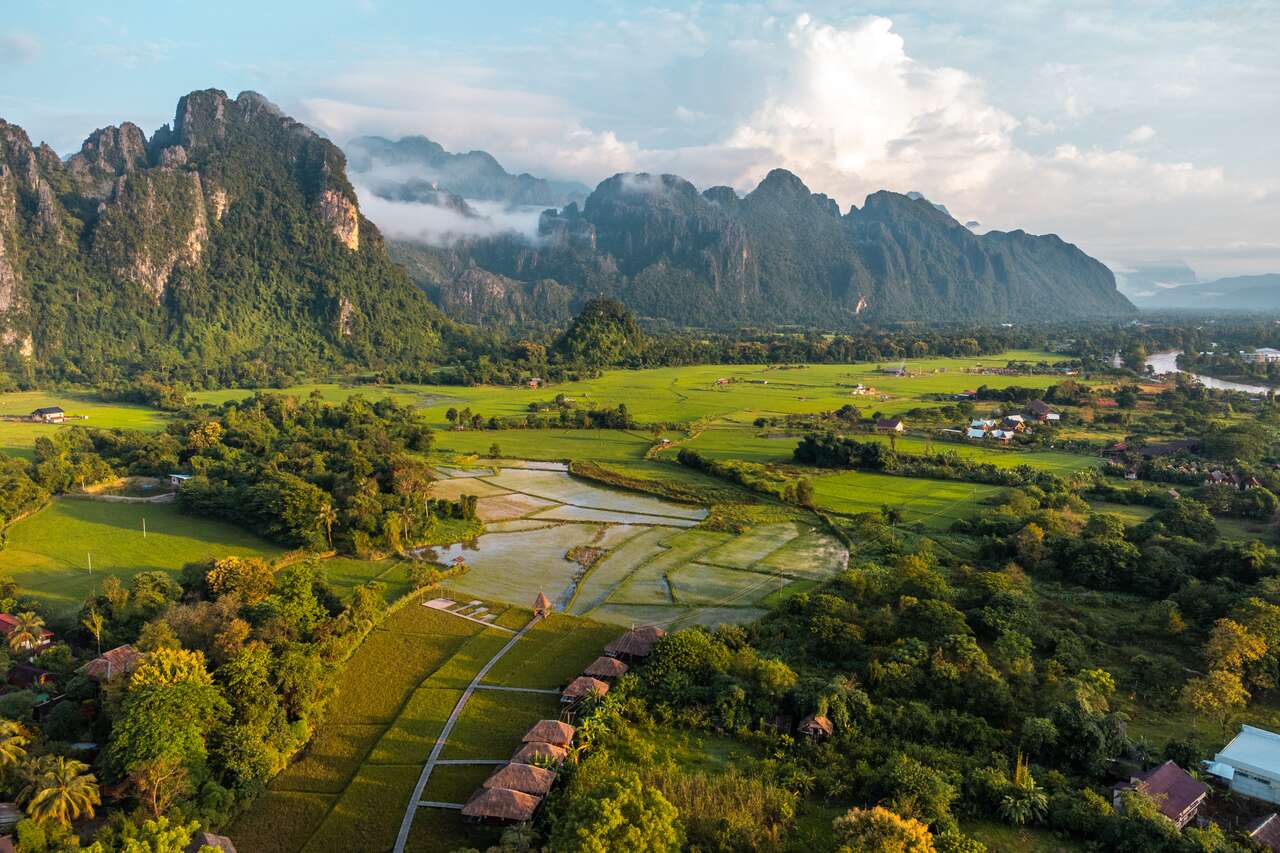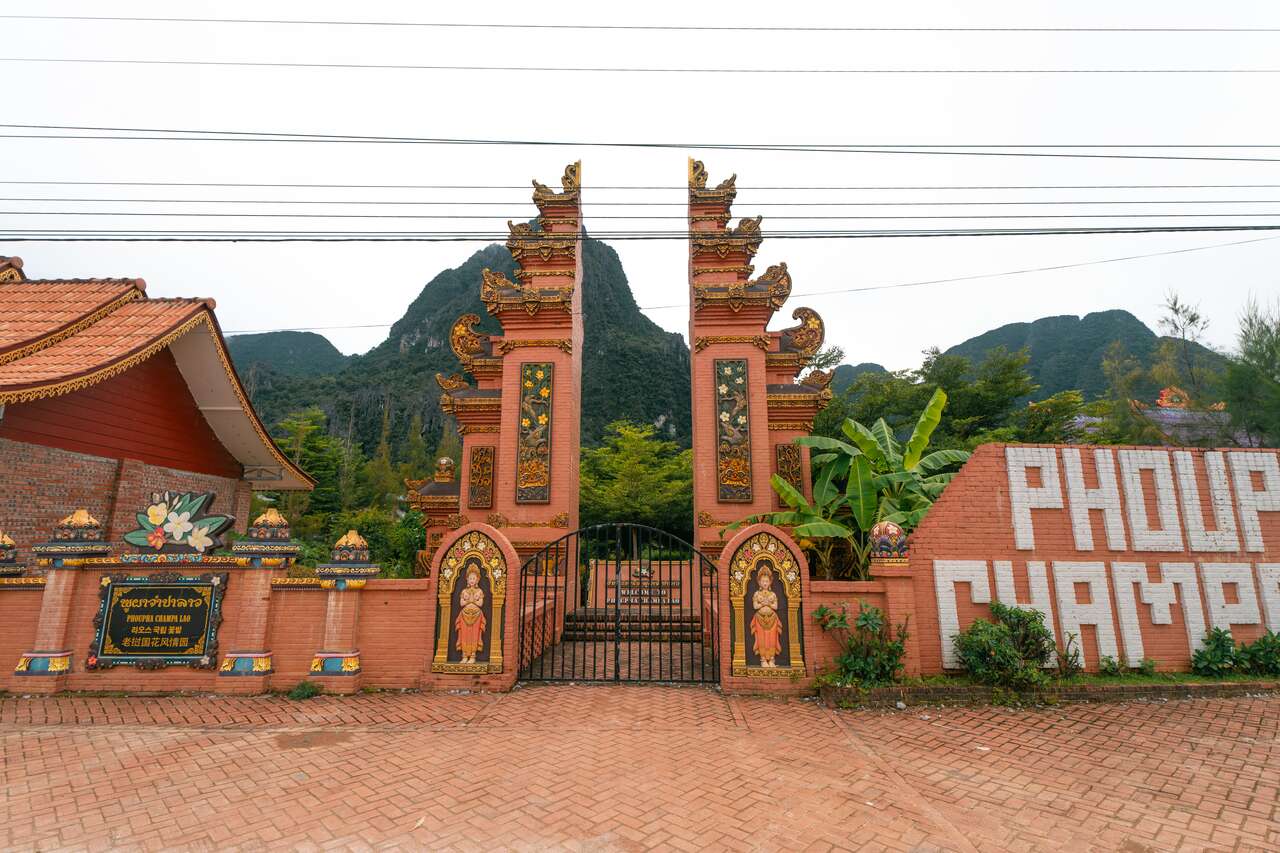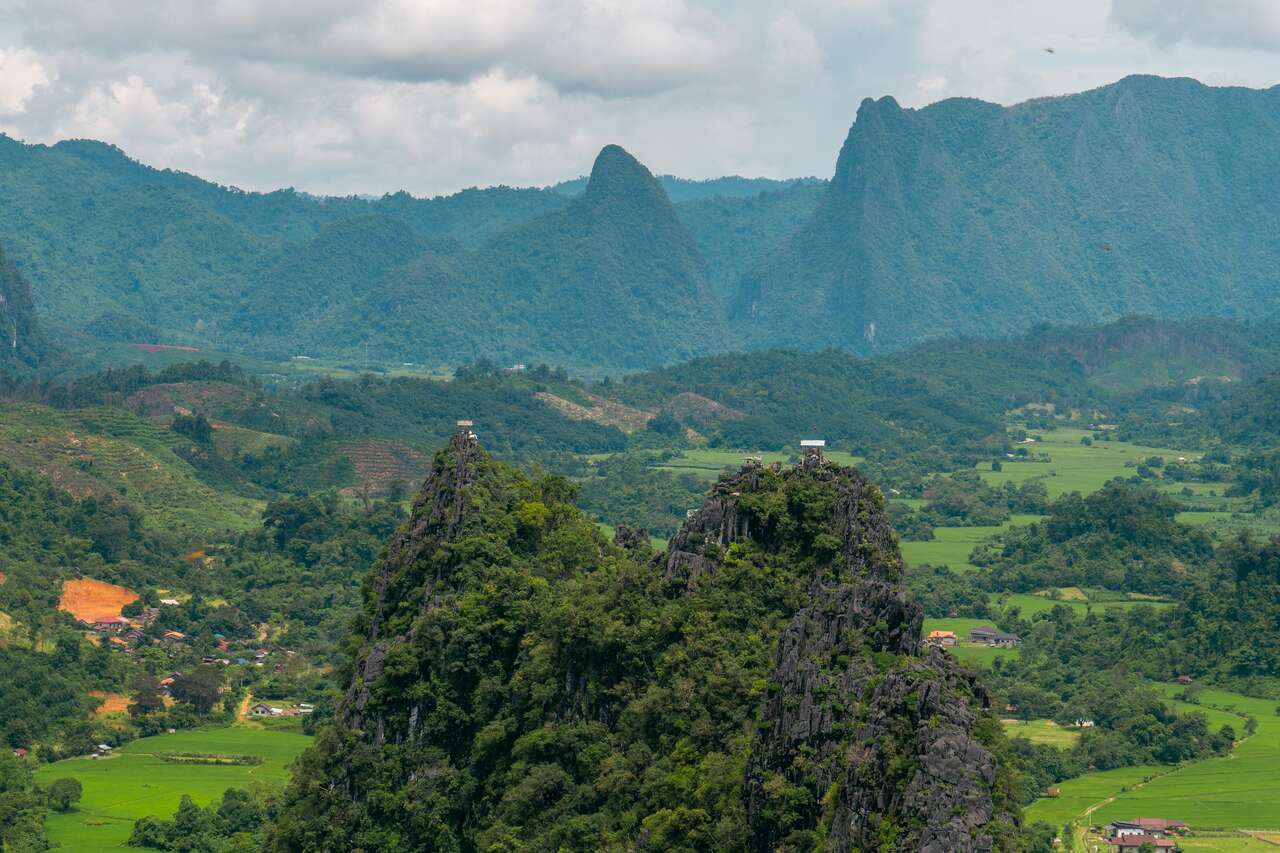Dive into the rich history of Vang Vieng, Laos with our 2025 guide! Learn about its ancient roots, cultural heritage, eco-friendly Vang Vieng Tours, and top providers for a sustainable adventure with Vang Vieng Travel. Plan your journey today!
Author Bio: Written by Tony Bùi, with over 20 years of experience in the travel industry, personally guiding and organizing tours for over 100,000 travellers across Southeast Asia. This guide draws from firsthand insights, guest feedback from Legend Travel Group surveys, and official sources like en.wikipedia.org, culturetrip.com, holiday-weather.com, weareglobaltravellers.com, localvietnam.com, and laos-guide-999.com. Information based on latest data as of August 23, 2025; verify before travel. Reflects Laos’ updated travel regulations.
Vang Vieng, a scenic town in Vientiane Province, Laos, located at 18.93°N, 102.45°E and 245 meters elevation, is renowned for its karst mountains, Nam Song River, and adventure activities like tubing and caving holiday-weather.com. Beyond its adventure appeal, Vang Vieng has a rich historical narrative shaped by its ancient settlements, Buddhist heritage, and transformation into a tourism hub culturetrip.com. Exploring Vang Vieng’s history with guided Vang Vieng Tours immerses you in its origins as a rural village, its role in regional trade, and its modern evolution as a backpacker haven weareglobaltravellers.com. A blend of Lao Buddhist traditions, ethnic diversity, and historical resilience, Vang Vieng, facilitated by trusted Vang Vieng Travel providers, is ideal for history enthusiasts, culture lovers, and eco-conscious travelers. Mastering Exploring Vang Vieng History cultural etiquette ensures a respectful journey, enhancing this historical adventure.
Following Laos’ updated travel regulations in 2025, Vang Vieng is accessible via bus from Vientiane (3–4 hours) or Luang Prabang (5–6 hours), with local transport like tuk-tuks, bicycles, or motorbikes, making historical exploration seamless. This guide blends historical insights, practical visiting tips, and sustainable Vang Vieng Travel ideas for a memorable experience.
Exploring Vang Vieng’s history requires a visa for most nationalities ($25–$50); ASEAN countries enjoy visa-free entry for 14–30 days. Entry to temples like Wat Si Sou Mang is free, with donations ($0.20–$1 or 2,000–10,000 LAK) appreciated; cave entry (e.g., Tham Chang) costs $1–$2 (10,000–20,000 LAK). Guided tours cost $15–$80 (150,000–800,000 LAK), and market purchases range from $0.20–$10 (2,000–100,000 LAK). Key sites are accessible by foot, bicycle, or tuk-tuk from Vang Vieng town. Verify schedules and visa requirements via laos-guide-999.com.
 Learn Vang Vieng’s rich past with expert guidance (Source: Internet)
Learn Vang Vieng’s rich past with expert guidance (Source: Internet)Ancient Settlements (Pre-14th Century): Vang Vieng was a small settlement of Lao and ethnic groups (Hmong, Khmu) along the Nam Song River, using caves like Tham Chang for shelter and spiritual practices. Its name, meaning "Golden Palace," reflects early cultural significance en.wikipedia.org.
Lan Xang Kingdom (14th–18th Century): Vang Vieng was part of the Lan Xang Kingdom, serving as a minor trade outpost along the Nam Song River, connecting northern and southern Laos. Buddhist temples like Wat Si Sou Mang emerged during this period culturetrip.com.
Colonial Era (19th–20th Century): Under French colonial rule (1893–1953), Vang Vieng remained a quiet village with minimal development, though its strategic river location supported local trade. Colonial influences are subtle, seen in some architectural remnants weareglobaltravellers.com.
Post-Independence and Tourism Boom (20th Century–Present): After Laos’ independence in 1953, Vang Vieng grew as a rural hub. The 1990s backpacker boom, driven by tubing and caving, transformed it into a tourism hotspot, with infrastructure like guesthouses and the Vang Vieng airstrip (now disused) holiday-weather.com. Post-2012 regulations curbed excessive partying, emphasizing cultural and eco-tourism localvietnam.com.
Cultural Preservation: Vang Vieng maintains its Buddhist heritage through temples and festivals like Lao New Year, with efforts to preserve caves and markets despite tourism growth localvietnam.com.
Tham Chang Cave: A historically significant cave used for shelter and spiritual practices by early settlers, now a cultural and tourist site (entry: $1–$2 or 10,000–20,000 LAK, open 8:00 AM–4:00 PM) culturetrip.com.
Wat Si Sou Mang: A historic Buddhist temple central to Vang Vieng’s spiritual life, hosting alms-giving and festivals (entry: free, donations $0.20–$1 or 2,000–10,000 LAK, open 7:00 AM–5:00 PM) holiday-weather.com.
Vang Vieng Morning Market: A historical trade hub with roots in the town’s river commerce, offering insights into local life (entry: free, open 6:00 AM–6:00 PM daily) weareglobaltravellers.com.
Nam Song Riverfront: A historical and cultural hub for trade and festivals like Boun Ok Phansa, reflecting Vang Vieng’s river-based heritage (entry: free, open 24/7) localvietnam.com.
Cultural etiquette ensures a respectful experience at historical sites during Vang Vieng Tours. Here’s your guide, based on current norms as of August 23, 2025:
Greetings: Offer a “sabaidee” (hello) with a slight nod or hands pressed together; use both hands when paying entry fees or offering donations to show respect, especially in temples or markets.
Dress: Wear modest clothing covering shoulders and knees for temples like Wat Si Sou Mang or markets; a lightweight scarf ($1 or 10,000 LAK) aligns with local norms culturetrip.com.
Behaviour: Maintain a quiet demeanor in temples and markets; ask permission before photographing locals or monks, especially during rituals or festivals; avoid touching sacred items or historical artifacts. A guest shared: “Respecting Lao customs made our historical exploration in Vang Vieng profound.”
Customs: Entry to temples and markets is free with donations ($0.20–$1 or 2,000–10,000 LAK) appreciated; Tham Chang Cave entry: $1–$2 (10,000–20,000 LAK); remove shoes in temples; tipping is not mandatory but appreciated ($0.20–$1 or 2,000–10,000 LAK); avoid public criticism of the government (penalties apply). Avoid littering to preserve caves and riverfronts culturetrip.com.
Tip: Say “khob chai” (thank you) to locals or guides; use eco-friendly practices like carrying reusable water bottles ($2 or 20,000 LAK) to support sustainable Vang Vieng Travel; maintain respect in communal spaces. Tony Bùi notes: “In 20 years guiding, I’ve seen respectful travellers thrive in Vang Vieng’s historical sites.”
General Tips:
Language: Carry a phrase card ($1 or 10,000 LAK) for Lao basics like “khob chai”; English is limited in Vang Vieng, but tourist areas are more accommodating culturetrip.com.
Respect: Follow temple rules (remove shoes, avoid touching sacred items); avoid disrupting festivals; support local artisans with fair purchases at Vang Vieng Morning Market.
Navigation: Key sites like Tham Chang Cave and Wat Si Sou Mang are accessible by foot, bicycle, or tuk-tuk from Vang Vieng town; use offline maps (Maps.me) with “Vang Vieng” or “Nam Song River” for navigation.
Eco-Tip: Use walking or bicycles ($1–$2/day or 10,000–20,000 LAK) to reduce emissions, aligning with Laos’ green tourism goals.
Note: Etiquette reflects current norms; verify site hours via laos-guide-999.com.
 Start your historical journey with Vang Vieng’s serene glow (Source: Internet)
Start your historical journey with Vang Vieng’s serene glow (Source: Internet)Below is a curated list of tour options for exploring Vang Vieng’s history, based on latest data from holiday-weather.com, culturetrip.com, weareglobaltravellers.com, and localvietnam.com. Confirm schedules and prices before booking.
Details: Visit Tham Chang Cave, Wat Si Sou Mang, Vang Vieng Morning Market, and Nam Song Riverfront independently; suitable for history enthusiasts; low to moderate difficulty.
Schedule: Daily; Tham Chang Cave open 8:00 AM–4:00 PM ($1–$2 or 10,000–20,000 LAK); Wat Si Sou Mang open 7:00 AM–5:00 PM (free, donations $0.20–$1 or 2,000–10,000 LAK); Vang Vieng Morning Market open 6:00 AM–6:00 PM (free); Nam Song Riverfront accessible 24/7 (free).
Cost: Cave entry: $1–$2 (10,000–20,000 LAK); temple/market entry: free (donations $0.20–$1 or 2,000–10,000 LAK); transport (bicycle: $1–$2/day or 10,000–20,000 LAK; tuk-tuk: $1–$3 or 10,000–30,000 LAK); market purchases: $0.20–$10 (2,000–100,000 LAK).
Location: Vang Vieng, Vientiane Province, Laos.
Eco-Friendly Note: Walk or use bicycles to reduce emissions; avoid littering at caves or riverfronts.
Tip: Check schedules at holiday-weather.com; visit early (7:00 AM) for serenity; a guest noted: “Self-guided historical visits were immersive and authentic.”
Details: 1-day group tour visiting Wat Si Sou Mang and Vang Vieng Morning Market; includes English-speaking guide, transport from Vang Vieng, lunch, and entry fees; low difficulty.
Schedule: Daily; departs 8:00 AM from Vang Vieng hotels; returns by 4:00 PM.
Cost: $25–$40/person (250,000–400,000 LAK, includes entries).
Pick-up/Drop-off: Hotels in Vang Vieng.
Eco-Friendly Note: Group transport with fuel-efficient vehicles minimizes impact; supports local artisans.
Tip: Book via legendtravelgroup.com; a guest noted: “Legend’s tour brought Vang Vieng’s history to life.”
Details: 1-day guided tour visiting Wat Si Sou Mang and a Nam Song River cruise; includes English-speaking guide, transport from Vang Vieng, lunch, and entry fees; low to moderate difficulty.
Schedule: Daily; departs 7:30 AM from Vang Vieng hotels; returns by 4:00 PM.
Cost: $30–$50/person (300,000–500,000 LAK, includes entries).
Pick-up/Drop-off: Hotels or designated points in Vang Vieng.
Eco-Friendly Note: Small groups reduce environmental impact; supports local communities.
Tip: Book via localvietnam.com; a guest noted: “The combo tour blended historical and river insights seamlessly.”
Details: 2–3 day tour combining Tham Chang Cave, Wat Si Sou Mang, Vang Vieng Morning Market, and Nam Song River cruise; includes English-speaking guide, transport, accommodation, meals, and entry fees; low to moderate difficulty.
Schedule: Daily; departs from Vang Vieng hotels; returns after 2–3 days.
Cost: $80–$200/person (800,000–2,000,000 LAK, includes entries).
Pick-up/Drop-off: Hotels or custom locations in Vang Vieng.
Eco-Friendly Note: Uses eco-lodges and fuel-efficient transport; supports local communities.
Tip: Book Vang Vieng Tours via legendtravelgroup.com or WhatsApp (+84 825862222); a guest noted: “The multi-day tour was a deep dive into Vang Vieng’s history.”
Self-Guided Exploration: Flexible and authentic, ideal for independent travellers with navigation skills.
Group Historical Tours: Affordable and guided, perfect for cultural and historical insights.
Combo Historical and River Tours: Blend temple visits with river experiences for a comprehensive journey.
Multi-Day Historical Tours: Offer in-depth exploration of Vang Vieng’s heritage, perfect for history enthusiasts.
Eco-Friendly Note: Group and multi-day tours use fuel-efficient transport or walking, supporting Laos’ green tourism goals.
 Capture the authentic charm of Vang Vieng’s historical scene (Source: Internet)
Capture the authentic charm of Vang Vieng’s historical scene (Source: Internet)Key historical exploration opportunities include:
Lao New Year (Boun Pi Mai): Typically April, vibrant with water fights and temple rituals, reflecting historical community traditions; warm and dry (25–34°C); check dates at laos-guide-999.com.
Boun Ok Phansa: Typically October, festive with illuminated boats on the Nam Song River, tied to Buddhist heritage; warm and rainy (22–32°C); check dates at laos-guide-999.com.
Vang Vieng Morning Market: Daily, ideal year-round for insights into historical trade; best in dry season (November–April) for comfortable weather weareglobaltravellers.com.
Dry season (November–April, 13–34°C) is ideal for temple visits and outdoor cultural events. Wet season (May–October, 22–32°C) suits indoor cultural experiences like market visits. Morning visits (7:00 AM–11:00 AM) avoid heat or crowds. Verify weather via accuweather.com.
Online Platforms: Book Vang Vieng Tours via localvietnam.com, legendtravelgroup.com, or weareglobaltravellers.com ($15–$80). Provide pick-up details (e.g., Vang Vieng hotels); e-tickets are acceptable, but printing is recommended.
Tour Operators: Contact agencies like Legend Travel Group for bundled tours with temples, markets, or river cruises.
Direct: Temple/market entry free (donations $0.20–$1 or 2,000–10,000 LAK); Tham Chang Cave: $1–$2 (10,000–20,000 LAK); book guided tours via local agencies (e.g., +856 23 511 707); confirm schedules via laos-guide-999.com.
Eco-Tip: Use digital tickets to reduce paper waste; opt for walking or bicycles ($1–$2/day or 10,000–20,000 LAK) to minimize emissions.
Tip: Book early for festivals (April, October); arrive by 7:00 AM for sites; carry small LAK notes for donations or purchases; confirm visa requirements ($25–$50 if needed).
 Begin your historical exploration with Vang Vieng’s tranquil ambiance (Source: Internet)
Begin your historical exploration with Vang Vieng’s tranquil ambiance (Source: Internet)Pack for a comfortable, sustainable visit:
Documents: Passport (valid 6+ months), Laos visa ($25–$50 if required), wallet ($2–$3 or 20,000–30,000 LAK), tour bookings.
Clothing: Modest clothing covering shoulders and knees; lightweight scarf ($1 or 10,000 LAK) for temple visits; quick-dry clothing and raincoat ($2 or 20,000 LAK) for wet season; lightweight clothing and light jacket ($5 or 50,000 LAK) for dry season; trekking shoes ($5 or 50,000 LAK); hat ($2 or 20,000 LAK).
Essentials: Reusable water bottle ($2 or 20,000 LAK); snacks ($0.20–$1 or 2,000–10,000 LAK, e.g., laap); small backpack ($2 or 20,000 LAK); sunscreen ($1 or 10,000 LAK); insect repellent ($1 or 10,000 LAK).
Tech: Phone with translation apps (e.g., Google Translate); charger ($5–$10 or 50,000–100,000 LAK); local SIM ($2–$3 or 20,000–30,000 LAK); camera ($20 or 200,000 LAK) for photos (with permission).
Eco Items: Reusable tote ($1 or 10,000 LAK) for market purchases; phrase card ($1 or 10,000 LAK) with Lao basics.
Extras: Small LAK notes for donations or purchases; small first aid kit ($2 or 20,000 LAK); umbrella ($2 or 20,000 LAK) for wet season; waterproof bag ($2 or 20,000 LAK) for valuables. Tip: Pack light (1 small bag, max 5 kg); reusable items support sustainability.
Historical Site Visit Costs
Self-Guided Exploration: Temple/market entry: free (donations $0.20–$1 or 2,000–10,000 LAK); Tham Chang Cave: $1–$2 (10,000–20,000 LAK); transport (bicycle: $1–$2/day or 10,000–20,000 LAK; tuk-tuk: $1–$3 or 10,000–30,000 LAK).
Group Historical Tours: $25–$40 (250,000–400,000 LAK, includes entries).
Combo Historical and River Tours: $30–$50 (300,000–500,000 LAK, includes entries).
Multi-Day Historical Tours: $80–$200 (800,000–2,000,000 LAK, includes entries). Transport Costs (for Self-Guided Visits)
Bicycle Rental: $1–$2/day (10,000–20,000 LAK).
Tuk-tuk: $1–$3 (10,000–30,000 LAK).
Motorbike: $5–$10/day (50,000–100,000 LAK). Other Costs
Donations: $0.20–$1 (2,000–10,000 LAK).
Market Snacks (e.g., laap, sticky rice): $0.20–$1 (2,000–10,000 LAK).
Souvenirs (e.g., Lao textiles, silver jewelry): $0.50–$10 (5,000–100,000 LAK). Total Daily Cost (Per Person)
Budget: $10–$30 (self-guided, snacks, transport).
Mid-range: $30–$60 (group tour, purchases).
Luxury: $60–$100 (private tour, premium souvenirs). Tip: Budget $10–$100 for tours, donations, or transport, and $0.20–$10 for purchases or add-ons.
Historical Tips: Visit Tham Chang Cave for ancient shelter insights; explore Wat Si Sou Mang for Buddhist heritage; visit Vang Vieng Morning Market for trade history; experience Nam Song Riverfront events for river-based traditions; purchase local crafts at markets.
Etiquette: Use “sabaidee” greeting; dress modestly; stay quiet in temples and markets; avoid touching sacred items; respect locals during festivals.
Access: Choose self-guided visits for flexibility, group tours for guided insights, or multi-day tours for deeper exploration.
Schedules: Sites open 6:00 AM–6:00 PM (Tham Chang 8:00 AM–4:00 PM); peak crowds in dry season (November–April); book tours early for festivals (April, October).
Sustainability: Use bicycles or walk; carry reusable items; support local artisans with fair purchases.
Navigation: Use offline maps (Maps.me) with “Vang Vieng” or “Nam Song River.”
Weather: Dry season (Nov–Apr, 13–34°C) ideal; wet season (May–Oct, 22–32°C) suits indoor activities; check forecasts via accuweather.com.
Safety Note: Secure valuables with a waterproof bag ($2 or 20,000 LAK); beware of pickpocketing in markets; carry emergency numbers (Police: 113, Laos Embassy: +856 21 251 000).
What is the history of Vang Vieng? Vang Vieng began as an ancient Lao settlement, grew as a Lan Xang trade outpost, remained rural under French rule, and became a tourism hub post-1990s en.wikipedia.org.
What are key historical sites in Vang Vieng? Tham Chang Cave, Wat Si Sou Mang, Vang Vieng Morning Market, and Nam Song Riverfront culturetrip.com.
How much are entry fees for historical sites? Temple/market entry free (donations $0.20–$1); Tham Chang Cave: $1–$2; guided tours: $15–$80.
How do I book historical tours? Book via localvietnam.com, legendtravelgroup.com, or local agencies; confirm schedules.
How do I reach historical sites? Walk, use bicycles, or tuk-tuks from Vang Vieng; tours include transport.
Are eco-friendly tours available? Yes, group tours with fuel-efficient transport or walking tours; check localvietnam.com.
Enhance your Vang Vieng historical journey with eco-conscious tours from Legend Travel Group:
Vang Vieng Historical Eco-Tour ($25–$40/person, 1 day): Guided temple and market visit with sustainable practices.
Vang Vieng Cultural and River Trail ($80–$150/person, 2 days): Combine historical sites with eco-friendly transport.
Northern Laos Explorer ($150–$250/person, 3 days): Multi-site adventure with eco-lodges and community-focused activities. Prices include guides, transport, and fees; group discounts available. Explore options at legendtravelgroup.com or contact sales@legendtravelgroup.com / WhatsApp (+84825862222) for your Vang Vieng Travel plans.
Exploring Vang Vieng History with cultural etiquette—modest attire, polite greetings like “sabaidee,” and respectful behavior—unlocks a profound, cultural journey through this Lao paradise. With tour costs from $15–$80, eco-friendly Vang Vieng Tours, and sites like Tham Chang Cave and Wat Si Sou Mang, this trip offers immersion and sustainability. Whether choosing a self-guided or guided experience with Vang Vieng Travel, visit early and respect local customs for the best experience. For more guides, check trusted resources like laos-guide-999.com. Safe travels!
Sources:
Historical Information: en.wikipedia.org, culturetrip.com, weareglobaltravellers.com, localvietnam.com
Cultural Norms: holiday-weather.com
Travel Details: laos-guide-999.com
Favorite experiences booked by travelers